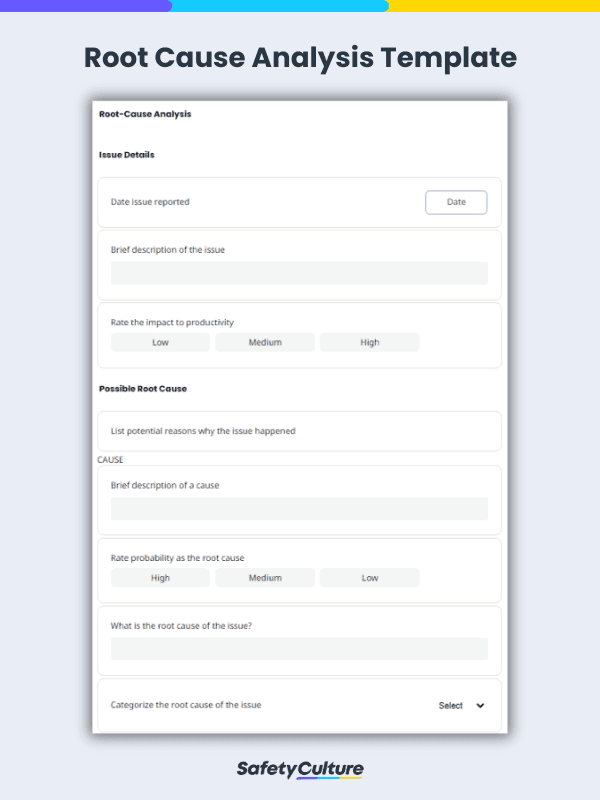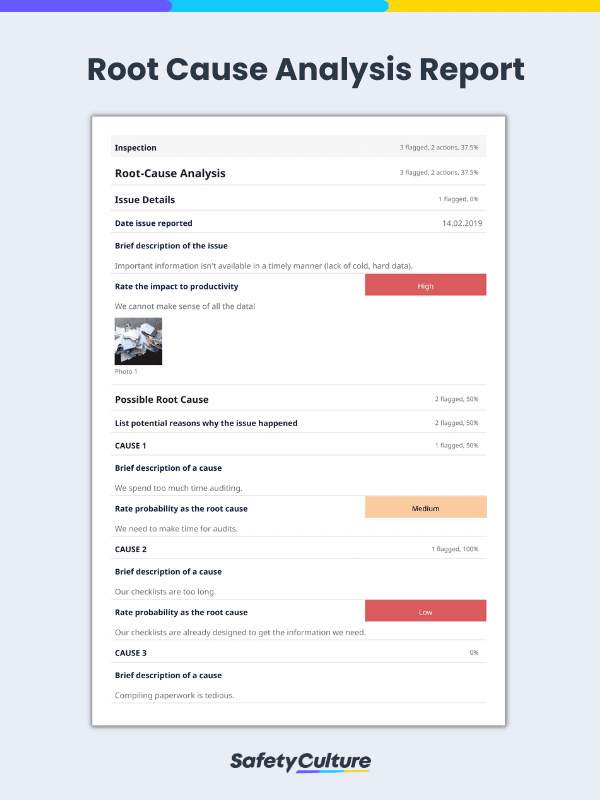What is Root Cause Analysis?
Root cause analysis (RCA) is a methodical approach in analyzing a problem and eliminating its root cause to solve counterproductive issues or events. Root cause analyses can help ensure the prevention of recurring problems, validating that RCA-recommended actions can improve business processes and boost productivity.
What is a Root Cause Analysis Template?
A root cause analysis template (also known as an RCA template) is used by cross-functional teams (CFTs) of subject matter experts to construct a good problem statement, collect relevant data, effectively identify the root cause, and implement lasting solutions. Utilizing mobile-ready root cause analysis templates can help teams take immediate action to resolve issues and cultivate a culture of collaboration and accountability.
Which RCA Tool is Right for Me?
Various tools are used to facilitate root cause analysis better, so it is crucial to have a clear understanding of the organization and its context to be able to pick the right RCA format. Moreover, different business problems entail a specific approach to reach an accurate conclusion of the root cause, formulate correct solutions, and achieve optimum results. Here are 4 of the best RCA tools to help you determine the right approach for your problem.
5 Whys Analysis (The Five Whys)
One of the most widely used problem-solving techniques is the 5 whys analysis. It is applied to universal problems across various industries due to its simple but practical nature, especially when implementing kaizen in your organization. With this root cause analysis format, pinpoint the root cause by asking, “Why did this problem occur?” five times. Use a 5 whys analysis template for initial root cause analysis and easily build a culture of collaboration and accountability among employees.
Failure Modes and Effects Analysis (FMEA)
An FMEA aims to anticipate potential problems before they happen so that their adverse effects on customers can be mitigated. Product design and process improvement professionals perform failure modes and effects analysis to prevent costly manufacturing failures and increase customer satisfaction. A highly functional FMEA template is crucial for success in implementing FMEAs.
8 Disciplines of Problem-Solving (8D)
Quality engineers in the automotive industry first developed 8D for comprehensive RCAs of critical problems in the production process. Applying the 8D approach in healthcare, retail, and manufacturing has also been proven to drive effective system changes. Conduct an 8D root cause analysis when safety or regulatory issues have been discovered in your business and repetitive customer complaints about your product/service are received. Permanent remedial actions based on data and information related to the problem can be established using an 8D template and an 8D RCA report.
Six Sigma Methodology (DMAIC)
For any project that needs improvement, follow the DMAIC process (Define, Measure, Analyze, Improve, Control) and focus efforts on the analyze phase. As the most recognized Six Sigma methodology, its strength lies in the structure and rigor from quantifying the problem to implementing long-term solutions. Use a digital DMAIC template to break down the root cause analysis by defining performance objectives, identifying value/non-value added process steps, and specifying the sources of variation.
Top 8 Root Cause Analysis Questions
Following one of the frameworks of one of the most comprehensive root cause analysis techniques, listed below are sample questions team leaders can ask when performing root cause analysis:
Question #1:
Is my problem-solving team trained enough and aware of their respective functions?
Question #2:
Does our problem statement answer the 5 Ws and 2 Hs for greater clarity and accuracy?
Question #3:
Can these actions temporarily isolate the problem from our customers in the future?
Question #4:
Does the root cause reveal nonconformance or hidden flaws in the system?
Question #5:
Can these possible solutions change the product and/or process conditions to permanently solve the problem?
Question #6:
Were actions communicated to all stakeholders to mitigate the risk and to measure improvements?
Question #7:
Were similar products and/or processes reviewed and work procedures updated for problem prevention?
Question #8:
Have I provided relevant feedback and recognized both team and individual efforts?
How to Do Root Cause Analysis
The root cause analysis can be done in a few simple steps which are as follows:
- Define the problem – This first step aims to recognize any issues, problems, or areas for improvement in any specific unit of the business or organization.
- Collect data – Gather evidence or relevant documentation that supports and investigates the elements involved in the identified problem.
- Determine possible causes – List events or situations that may be contributing factors to the cause of the problem.
- Identify the root cause – Using various tools and problem-solving methods available, specify the root cause of the problem.
- Implement solutions – Recommend and enforce possible solutions or preventive measures that would lessen, if not totally eliminate the problem or the root cause.
Learn more about how to comprehensively do the root cause analysis here.
Root Cause Analysis Examples
To offer further insight into how this tool can be applied by organizations, below are real-life examples of implementing root cause analysis in the manufacturing and construction industry:
Root Cause Analysis Example in Manufacturing
Problem: Innovative Ideas Corporation, a leading producer of raw materials for electronic gadgets, experienced a disruption in their daily operations. There’s an oil spill on the loading dock that has not only rendered a portion of the dock inaccessible but also poses a serious risk to the safety of workers and vehicles maneuvering in the area.
The on-site safety personnel was immediately dispatched to look into the issue and identify what caused the spill. Sawyer James Loren, the safety personnel, deemed it best to use the 5 Why’s method for this analysis.
- Why – The forklift is leaking oil
- Why – The gasket dried out
- Why – It was a cheap aftermarket gasket
- Why – We saved extra money by buying cheaper, aftermarket gaskets in bulk
- Why – The procurement department is incentivized to save money and not safety
Is the root cause of the problem identified? Yes. The main reason for the oil spill that created a workplace hazard is the incentive scheme that compromises the safety of the employees.
While performing the RCA and working through the 5 Whys, the management also implemented countermeasures along the way to mitigate short-term risks while working to implement corrective actions and preventive actions at the root cause level.
- Countermeasure – Clean up the oils spill
- Countermeasure – Replace the gasket
- Countermeasure – Pull the current stock of aftermarket gaskets
- Countermeasure – Order OEM gaskets
- Countermeasure – Realign the incentive program with safety
Root Cause Analysis Example in Construction
Problem: A backhoe operator in a busy construction site was maneuvering a backhoe when it suddenly jerked and made a loud clanging noise. The operator immediately stopped and realized that the backhoe had struck an underground utility line.
The project manager was immediately notified of the incident. An investigation using the 5 Whys method is used to deep-dive into the situation and identify the cause of the problem.
- Why was the line hit? – It wasn’t marked
- Why wasn’t it marked? – The existing records were not up to date and the line was not on the print
- Why were the records out of date? – The company who did the most recent work on the system didn’t submit their facility records in time
- Why didn’t they submit their utility records in time? – They have a bad process and the utility company didn’t catch it in time
- Why didn’t the utility company catch the fact that the records weren’t up to date? – Operations doesn’t collaborate well with the records department
Upon discovering the root cause of the problem, the project manager communicated to both parties. He reiterated the importance of keeping all the records updated consistently to avoid the recurrence of incidents that can cause safety hazards to the site and the people involved.
The utility company and the records department both guaranteed to communicate well and perform regular audits to make sure that all records are updated as often as necessary.
Root Cause Analysis Example in Logistics
Problem: A freight delivery time was missed
- Why was the delivery time missed? – Because the driver went to the wrong delivery address
- Why did he go to the wrong address? – Because the address on the delivery note was not clear
- What was the address unclear? – Because it had gotten wet
- Why had the delivery note become wet? – Because it was raining that day
- Why had the delivery note gotten wet in the rain? – Because there is no shelter in the dispatch yard for drivers to wait for the loading of their trucks
Countermeasures:
- Utilize onboard transport software to confirm route planning and delivery address
- Provide a paperless delivery note using SafetyCulture
- Build suitable welfare facilities for driver in dispatch yard
Also, below is an example of a completed Root Cause Analysis Report.
FAQs About Root Cause Analysis
RCA or root cause analysis is performed when an incident occurs and it results in an undesired outcome. An RCA is performed to help businesses determine and document the potential cause of that incident and create countermeasures to prevent its recurrence.
A root cause analysis is conducted by a small team. The team is composed of experienced personnel involved in the business process/area where the issue occurred.
A root cause analysis can be performed in 5 easy steps:
- Realize the problem
- Gather data
- Explore and determine potential causes
- Identify the root cause
- Recommend and implement solutions
An RCA document is a must if the aim is to complete an in-depth and effective analysis. Below are elements that you can consider for your root cause analysis to ensure all relevant details are well-accounted for in your form:
- Title Page – Include the basic details of your analysis session such as the date and location, as well as the name of the facilitator for proper documentation.
- Issue Details – Use a section of your RCA template to document the date the issue was reported, its brief description, and the rating of its impact on organizational or employee productivity.
- Possible Root Cause – List the potential reasons it happened, the main category of the issue (equipment, process, organization, or non-conformance, among others), and the identified or potential root cause of the issue.
- Next Steps/Recommendations – As part of the organization’s continuous effort in proactive prevention strategy, your RCA template must also include a section that lists the solution to be implemented, the estimated cost, and if there are special considerations or findings to be reviewed for corrective action.
- Completion/Sign-off – Lastly, use the final section of the RCA template to put the details of the RCA team, as well as the full name and signature of the facilitator or person-in-charge (PIC).




